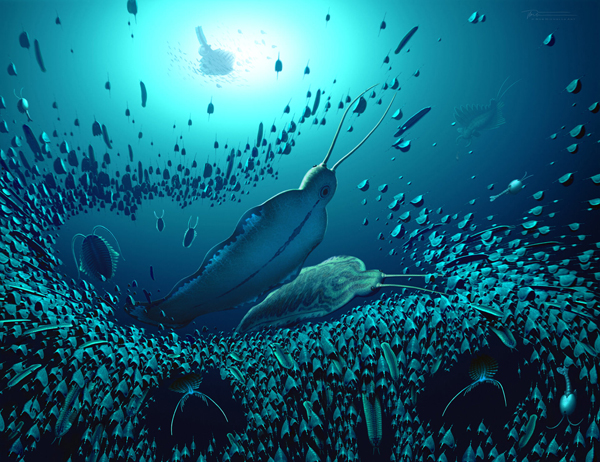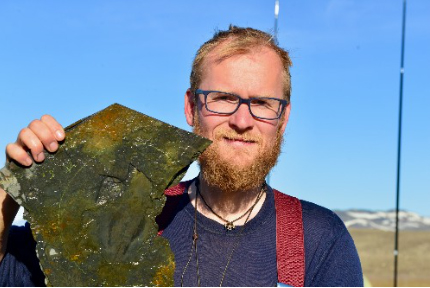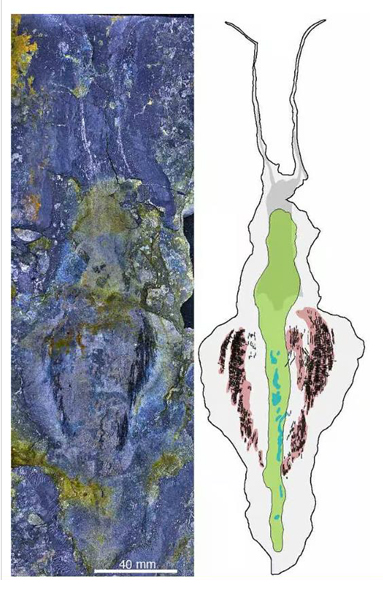Giant Predatory Worms from the Cambrian of Greenland
Scientists have named a new, probable apex predator from the Sirius Passet fossil locality in northern Greenland. Measuring in excess of thirty centimetres long, Timorebestia koprii was a giant pelagic predator. These marine worms may be some of the earliest carnivorous animals to have colonised the water column. The fossils are dated to approximately 518 million years ago and reveal a complex, multi-tiered marine ecosystem.

Picture credit: Bob Nicholls
The image (above) shows a pair of Timorebestia (T. koprii) attacking a shoal of the Cambrian arthropod Isoxys. Several other pelagic (active swimming) animals are featured in the artwork.
Timorebestia koprii
The genus name Timorebestia means “terror beasts” in Latin. These marine worms were some of the largest swimming animals in the Early Cambrian seas. They had fins down the sides of their body, a distinct head with long antennae and large jaw structures. The species has been erected in honour of the Korea Polar Research Institute (KOPRI). It is an acknowledgement of their support of the field expeditions to northern Greenland.
Senior author of the study published in “Science Advances”, Dr Jakob Vinther explained:
“We have previously known that primitive arthropods were the dominant predators during the Cambrian, such as the bizarre-looking anomalocaridids. However, Timorebestia is a distant, but close, relative of living arrow worms, or chaetognaths. These are much smaller ocean predators today that feed on tiny zooplankton.”

Picture credit: Dr Jakob Vinther
The Fossilised Digestive System of Timorebestia
Inside the fossilised digestive system of Timorebestia, the researchers found remains of a common, swimming arthropod called Isoxys.
Co-author, former PhD student at Bristol University, Morten Lunde Nielsen provided more information about Isoxys:
“We can see these arthropods were a food source for many other animals. They are very common at Sirius Passet and had long protective spines, pointing both forwards and backwards. However, they clearly didn’t completely succeed in avoiding that fate, because Timorebestia munched on them in great quantities.”

Picture credit: Dr Jakob Vinther
Arrow Worms
Described as a stem chaetognath (arrow worm), Timorebestia represents a significant discovery. Chaetognaths are one of the oldest animal groups known from the Cambrian. For example, arthropods appear in the fossil record as far back as 529 million years ago, but arrow worms can be traced back to at least 538 million years ago.
Dr Vinther has suggested that both arrow worms and the more primitive Timorebestia were swimming predators. It can be surmised that these marine worms were the dominant pelagic predators before the arthropods.
He stated:
“Perhaps they had a dynasty of about 10-15 million years before they got superseded by other, and more successful, groups.”
Luke Parry from Oxford University, who was part of the research team, added:
“Timorebestia is a really significant find for understanding where these jawed predators came from. Today, arrow worms have menacing bristles on the outside of their heads for catching prey, whereas Timorebestia has jaws inside its head. This is what we see in microscopic jaw worms today, organisms that arrow worms shared an ancestor with over half a billion years ago. Timorebestia and other fossils like it provide links between closely related organisms that today look very different.”
Everything Dinosaur acknowledges the assistance of a media release from the University of Bristol in the compilation of this article.
The scientific paper: “A giant stem-group chaetognath” by Tae-Yoon S. Park, Morten Lunde Nielsen, Luke A. Parry, Martin Vinther Sørensen, Mirinae Lee, Ji-Hoon Kihm, Ji-Hoon Kihm, Changkun Park, Giacinto de Vivo, M. Paul Smith, David A. T. Harper, Arne T. Nielsen and Jakob Vinther published in Science Advances.
The Everything Dinosaur website: Everything Dinosaur.

